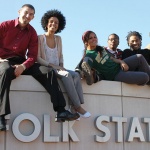
 |
|||||||
|
Chartered in 1974, the University of the District of Columbia is the only fully-accredited public institution of higher education in the nation’s capital. As an urban land-grant university, it supports a broad mission of education, research and community service and offers bachelors and masters degrees in the College of Arts and Science, School of Business and Public Administration and the School of Engineering and Applied Sciences. In August 2009, UDC inaugurated a new community college which offers more than 20 associate degree and certificate programs as well as over 25 workforce development programs to prepare students for successful careers and academic advancement. As the District’s alma mater, UDC attracts students of every age from the Washington, DC region, the nation and the world—providing innovative, results-driven programs that enrich our city with educated, qualified students, ready to work and contribute to its overall prosperity and quality of life. Online Admissions Application: http://www.udc.edu/apply/ |
|||||||
| Quick Facts | |||||||
| Undergrad Population: 5311 Graduate Population: 207 Student Body: Coed In State Tuition: $7000 Out of State Tuition: $1400 Room & Board: $1100 Applications Due: Spring: November 15, Sum ($75) |
Conference: Independent/ East Coast Conference Mascot: Firebirds Accreditations: Online Classes: no Percent Men: 39% Percent Women: 61% |
||||||
| University of the District of Columbia Related Video | |||||||
|
|||||||
| News and Upcoming Events at University of the District of Columbia | |||||||
|
|||||||
| The Wall | |||||||
| Future spot for testimonials, comments, pictures, video | |||||||
| Majors Offered | |||||||
| College of Agriculture, Urban Sustainability & Environmental Sciences
Baccalaureate Degrees Master’s Degrees College of Arts & Sciences Baccalaureate Degrees Master’s Degrees National Center for Urban Education School of Business & Public Administration Baccalaureate Degrees Master’s Degrees School of Engineering & Applied Sciences Baccalaureate Degrees Master’s Degrees Professional Degrees |
|||||||
| Unique Programs | |||||||
| Sports & Extra Curricular Activities | |||||||
| Choir, Choral Groups, Dance, Fraternities, Jazz Band, Marching Band, Radio Station, Sororities, Student Newspaper, Television Station | |||||||
| College History | |||||||
|
The University of the District of Columbia is, at once, very old and very new. The seeds of higher education for the District were planted in 1851 when Myrtilla Miner founded a school for colored girls. In 1879, Miner Normal School became a part of the public school system. Similarly, Washington Normal School, established in 1873, as a school for white girls, was renamed Wilson Normal School in 1913. In 1929, by an act of Congress, both schools became four-year teachers colleges, Miner Teachers College and Wilson Teachers College, and the only institutions of public higher education in the city. Years later, after the long awaited Supreme Court desegregation decision, the two colleges united in 1955 to form the District of Columbia Teachers College. However, for many residents who did not wish to become teachers or who were both black and poor, the opportunity for advanced technical training or study for liberal arts degree was an unattainable goal. Years of persistent lobbying for comprehensive public higher education by District residents and others caused President John F. Kennedy, in 1963, to appoint a commission to study the Districts needs. It was no surprise that the Chase Commission found a definite and compelling need for public higher education in the District of Columbia. There was a demand for instruction that was affordable, and there was an over whelming desire for learning that would enable residents to participate fully in the unique life of the city. The Commissions report stimulated congressional action. Under the leadership of Senator Wayne Morse and Congressman Ancher Nelson, the Public Education Act (Public Law 89-791) was enacted in 1966. Two schools were established: Federal City College, whose Board of Higher Education was appointed by the Mayor of the District of Columbia, and Washington Technical Institute, whose Board of Vocational Education was appointed by the President of the United States. The mission of both institutions was to serve the needs of the community by directing the resources and knowledge gained through education toward the solution to urban problems. As a sign of hope for the future, both schools proudly opened their doors in 1968. There were so many applications for admission to Federal City College that students were selected by lottery. Congress passed more than 100 years after the passing of first Morrill Land Grant. College Act Federal City College and the Washington Technical Institute achieved land grant status in 1968. Rapidly, the two schools grew in academic stature. The Washington Technical Institute received its accreditation in 1971 and Federal City College in 1974. Although the schools were in their infancy, thoughts turned to a comprehensive university structure. In 1969, the District of Columbia Teachers College, the city’s oldest teacher training institution, was placed under the jurisdiction of the Board of Higher Education. In 1974, the Board established a joint administrative support system and placed the District of Columbia Teachers College and Federal City College under a single president. After Congress granted limited home rule to the District of Columbia, D.C. Law 1-36 authorized the mandate for consolidation of the three schools in 1975. A new Board of Trustees took office in May 1976, consisting of 11 members appointed by the Mayor, three appointed by the alumni associations. From that moment, the monumental task of shaping a new University of the District of Columbia began. The Board of Trustees, acting to effect the consolidation, assigned Presidents Wendell P. Russell of Federal City College and Cleveland L. Dennard of Washington Technical Institute to work jointly in identifying, developing, and implementing tasks required to complete the effort. Beginning in February 1977, 22 tasks forces were formed to develop recommendations for Board action. On August 1, 1977, the Board of Trustees publicly announced the consolidation of the District of Columbia Teachers College, the Federal City College, and the Washington Technical Institute into the University of the District of Columbia under a single management system. On the same day, the Board appointed Lisle Carleton Carter, Jr., the first president of The University. In 1977, under the direction of President Carter, academic components began planning for consolidation of academic programs. These efforts culminated in the establishment of five programmatic colleges of Business and Public Management; Education and Human Ecology; Liberal and Fine Arts; Life Sciences Physical Science, Engineering and Technology University College, Continuing Education, and several academic units, which comprised The University of the District of Columbia. From 1994 to the present, new academic consolidations have been implemented. The University currently offers 75 undergraduate and graduate academic degree programs through the following college and schools: College of Arts and Sciences, School of Business and Public Administration, School of Engineering and Applied Sciences, and the UDC David A. Clarke School of Law. Additionally, The University’s public service arm, the Division of Community Outreach and Extension Services (COES), offers a variety of practical, nonacademic educational programs and training to the citizens of the District of Columbia. |
|||||||
You can check out the latest casting calls and Entertainment News by clicking: Click Here
Click the logo below to go to the Home Page of the Website
Click the logo below to follow ETInside on Twitter
Click the logo below to follow ETInside on Facebook
Click the logo below to follow ETInside on Instagram
Click the logo below to follow ETInside on Pinterest
Click the logo below to follow ETInside on Medium












